Business Finance Report: Event Planners Ltd and Toodlers Ltd Analysis
VerifiedAdded on 2019/12/28
|13
|3754
|158
Report
AI Summary
This report delves into key aspects of business finance, focusing on cash flow, liquidity, and investment appraisal techniques. It presents two scenarios: Event Planners Ltd, a newly established business facing cash flow and liquidity issues, and Toodlers Ltd, a manufacturing company evaluating capital budgeting for new product development. The report distinguishes between cash flow and profit, analyzes the characteristics of liquidity and profitability, and explores reasons for cash shortages. It suggests ways to mitigate cash flow difficulties, such as controlling overheads, examining service costs, and implementing cash flow budgeting. Furthermore, the report discusses investment appraisal techniques, including the capital budgeting process, to aid in making strategic investment decisions. The analysis covers identifying opportunities, evaluating proposals, project analysis, capital budgeting planning, and project selection. The report aims to provide insights into managing financial challenges and making informed investment choices within a business context.
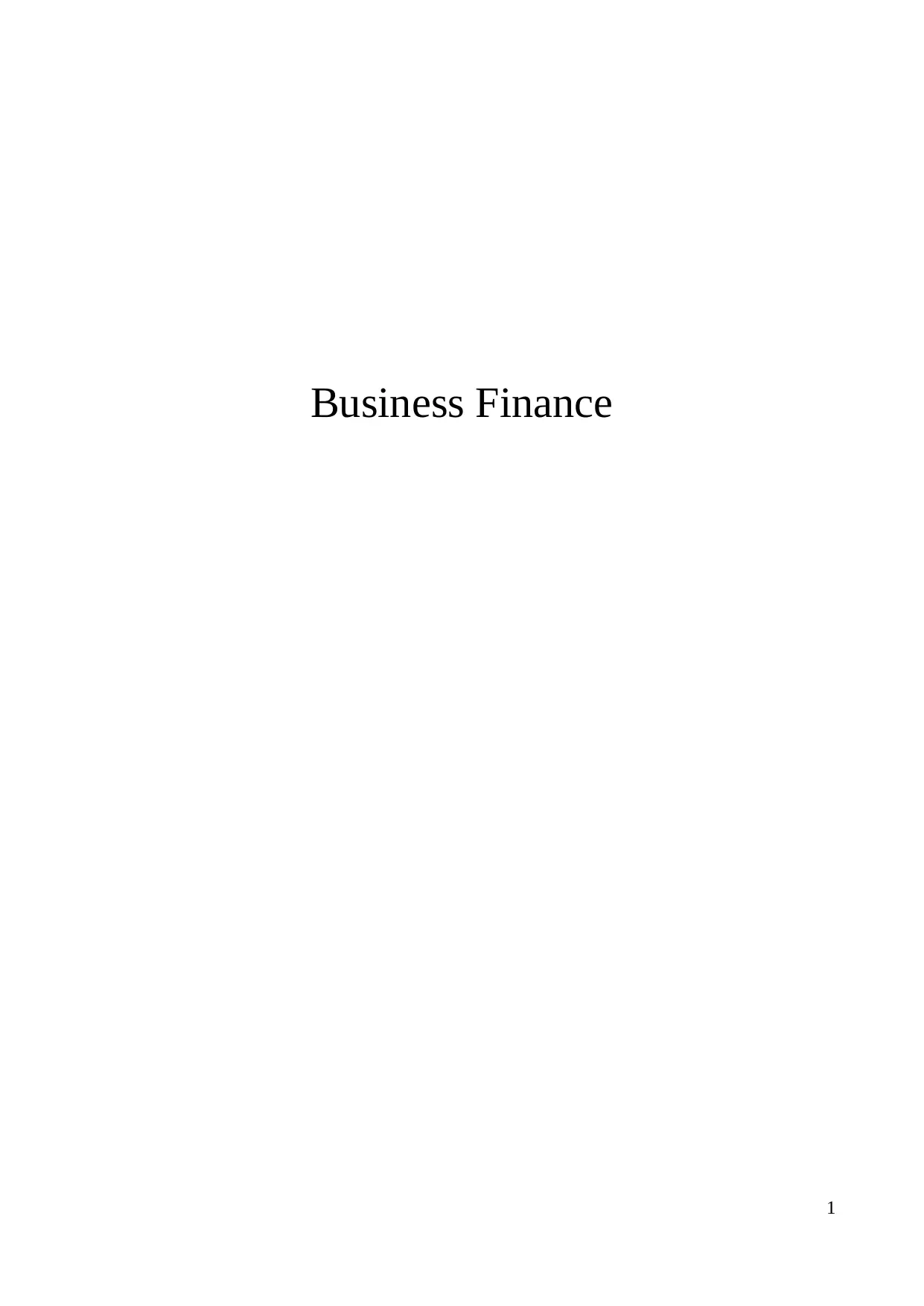
Business Finance
1
1
Paraphrase This Document
Need a fresh take? Get an instant paraphrase of this document with our AI Paraphraser

Table of Contents
INTRODUCTION ..............................................................................................................................3
SCENARIO ONE.................................................................................................................................3
SCENARIO TWO................................................................................................................................6
CONCLUSION..................................................................................................................................10
REFERENCES...................................................................................................................................11
2
INTRODUCTION ..............................................................................................................................3
SCENARIO ONE.................................................................................................................................3
SCENARIO TWO................................................................................................................................6
CONCLUSION..................................................................................................................................10
REFERENCES...................................................................................................................................11
2
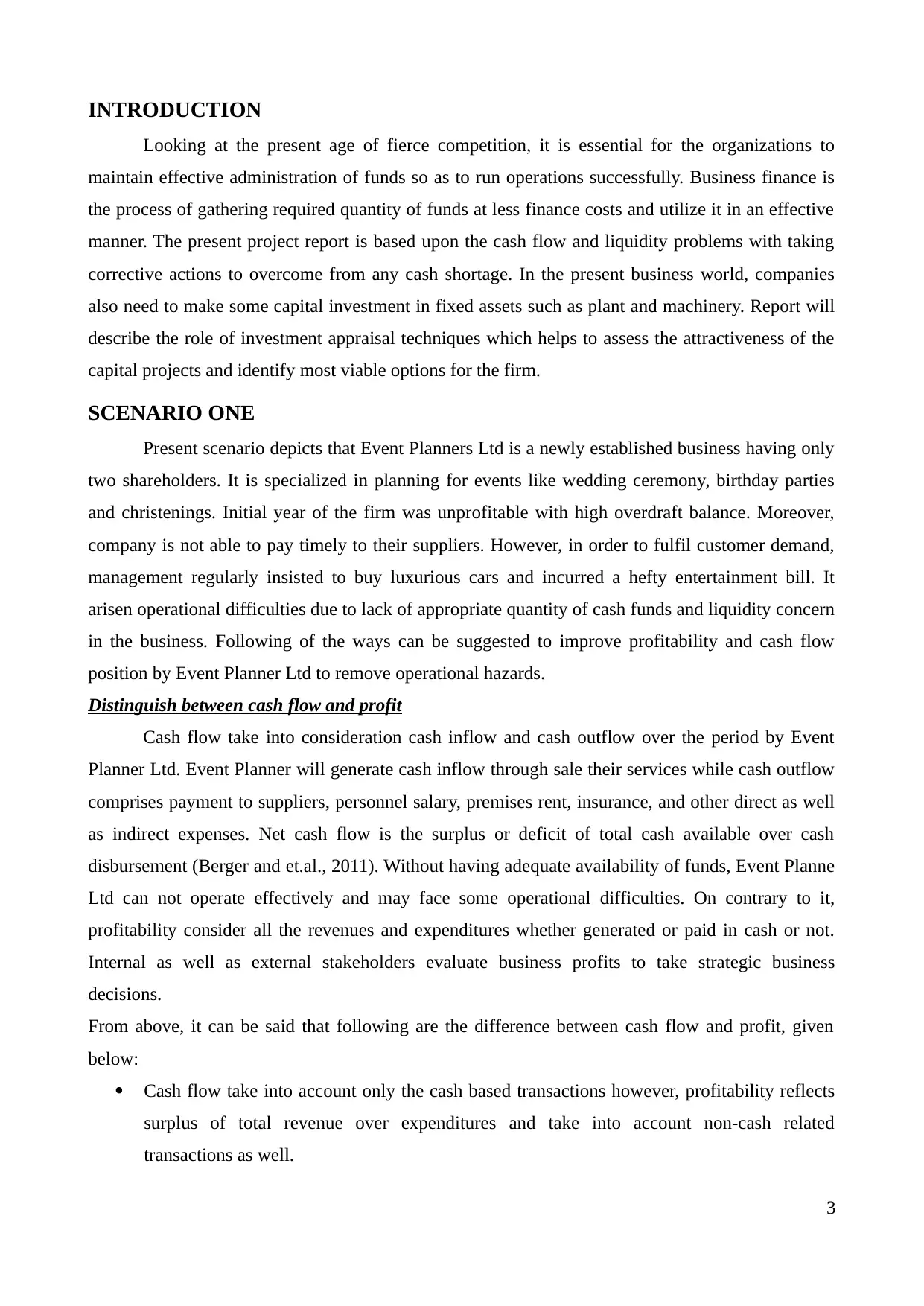
INTRODUCTION
Looking at the present age of fierce competition, it is essential for the organizations to
maintain effective administration of funds so as to run operations successfully. Business finance is
the process of gathering required quantity of funds at less finance costs and utilize it in an effective
manner. The present project report is based upon the cash flow and liquidity problems with taking
corrective actions to overcome from any cash shortage. In the present business world, companies
also need to make some capital investment in fixed assets such as plant and machinery. Report will
describe the role of investment appraisal techniques which helps to assess the attractiveness of the
capital projects and identify most viable options for the firm.
SCENARIO ONE
Present scenario depicts that Event Planners Ltd is a newly established business having only
two shareholders. It is specialized in planning for events like wedding ceremony, birthday parties
and christenings. Initial year of the firm was unprofitable with high overdraft balance. Moreover,
company is not able to pay timely to their suppliers. However, in order to fulfil customer demand,
management regularly insisted to buy luxurious cars and incurred a hefty entertainment bill. It
arisen operational difficulties due to lack of appropriate quantity of cash funds and liquidity concern
in the business. Following of the ways can be suggested to improve profitability and cash flow
position by Event Planner Ltd to remove operational hazards.
Distinguish between cash flow and profit
Cash flow take into consideration cash inflow and cash outflow over the period by Event
Planner Ltd. Event Planner will generate cash inflow through sale their services while cash outflow
comprises payment to suppliers, personnel salary, premises rent, insurance, and other direct as well
as indirect expenses. Net cash flow is the surplus or deficit of total cash available over cash
disbursement (Berger and et.al., 2011). Without having adequate availability of funds, Event Planne
Ltd can not operate effectively and may face some operational difficulties. On contrary to it,
profitability consider all the revenues and expenditures whether generated or paid in cash or not.
Internal as well as external stakeholders evaluate business profits to take strategic business
decisions.
From above, it can be said that following are the difference between cash flow and profit, given
below:
Cash flow take into account only the cash based transactions however, profitability reflects
surplus of total revenue over expenditures and take into account non-cash related
transactions as well.
3
Looking at the present age of fierce competition, it is essential for the organizations to
maintain effective administration of funds so as to run operations successfully. Business finance is
the process of gathering required quantity of funds at less finance costs and utilize it in an effective
manner. The present project report is based upon the cash flow and liquidity problems with taking
corrective actions to overcome from any cash shortage. In the present business world, companies
also need to make some capital investment in fixed assets such as plant and machinery. Report will
describe the role of investment appraisal techniques which helps to assess the attractiveness of the
capital projects and identify most viable options for the firm.
SCENARIO ONE
Present scenario depicts that Event Planners Ltd is a newly established business having only
two shareholders. It is specialized in planning for events like wedding ceremony, birthday parties
and christenings. Initial year of the firm was unprofitable with high overdraft balance. Moreover,
company is not able to pay timely to their suppliers. However, in order to fulfil customer demand,
management regularly insisted to buy luxurious cars and incurred a hefty entertainment bill. It
arisen operational difficulties due to lack of appropriate quantity of cash funds and liquidity concern
in the business. Following of the ways can be suggested to improve profitability and cash flow
position by Event Planner Ltd to remove operational hazards.
Distinguish between cash flow and profit
Cash flow take into consideration cash inflow and cash outflow over the period by Event
Planner Ltd. Event Planner will generate cash inflow through sale their services while cash outflow
comprises payment to suppliers, personnel salary, premises rent, insurance, and other direct as well
as indirect expenses. Net cash flow is the surplus or deficit of total cash available over cash
disbursement (Berger and et.al., 2011). Without having adequate availability of funds, Event Planne
Ltd can not operate effectively and may face some operational difficulties. On contrary to it,
profitability consider all the revenues and expenditures whether generated or paid in cash or not.
Internal as well as external stakeholders evaluate business profits to take strategic business
decisions.
From above, it can be said that following are the difference between cash flow and profit, given
below:
Cash flow take into account only the cash based transactions however, profitability reflects
surplus of total revenue over expenditures and take into account non-cash related
transactions as well.
3
⊘ This is a preview!⊘
Do you want full access?
Subscribe today to unlock all pages.

Trusted by 1+ million students worldwide
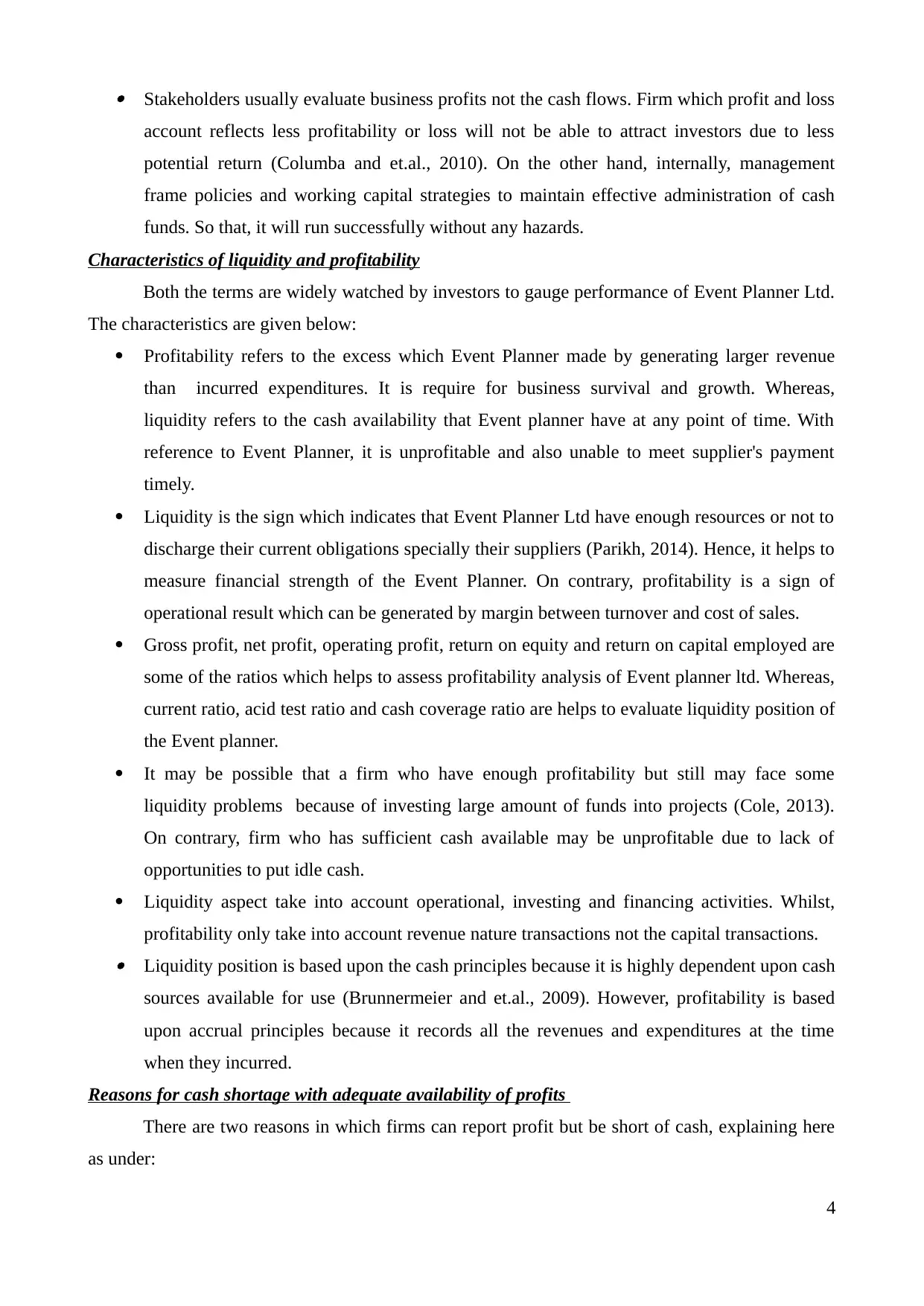
Stakeholders usually evaluate business profits not the cash flows. Firm which profit and loss
account reflects less profitability or loss will not be able to attract investors due to less
potential return (Columba and et.al., 2010). On the other hand, internally, management
frame policies and working capital strategies to maintain effective administration of cash
funds. So that, it will run successfully without any hazards.
Characteristics of liquidity and profitability
Both the terms are widely watched by investors to gauge performance of Event Planner Ltd.
The characteristics are given below:
Profitability refers to the excess which Event Planner made by generating larger revenue
than incurred expenditures. It is require for business survival and growth. Whereas,
liquidity refers to the cash availability that Event planner have at any point of time. With
reference to Event Planner, it is unprofitable and also unable to meet supplier's payment
timely.
Liquidity is the sign which indicates that Event Planner Ltd have enough resources or not to
discharge their current obligations specially their suppliers (Parikh, 2014). Hence, it helps to
measure financial strength of the Event Planner. On contrary, profitability is a sign of
operational result which can be generated by margin between turnover and cost of sales.
Gross profit, net profit, operating profit, return on equity and return on capital employed are
some of the ratios which helps to assess profitability analysis of Event planner ltd. Whereas,
current ratio, acid test ratio and cash coverage ratio are helps to evaluate liquidity position of
the Event planner.
It may be possible that a firm who have enough profitability but still may face some
liquidity problems because of investing large amount of funds into projects (Cole, 2013).
On contrary, firm who has sufficient cash available may be unprofitable due to lack of
opportunities to put idle cash.
Liquidity aspect take into account operational, investing and financing activities. Whilst,
profitability only take into account revenue nature transactions not the capital transactions. Liquidity position is based upon the cash principles because it is highly dependent upon cash
sources available for use (Brunnermeier and et.al., 2009). However, profitability is based
upon accrual principles because it records all the revenues and expenditures at the time
when they incurred.
Reasons for cash shortage with adequate availability of profits
There are two reasons in which firms can report profit but be short of cash, explaining here
as under:
4
account reflects less profitability or loss will not be able to attract investors due to less
potential return (Columba and et.al., 2010). On the other hand, internally, management
frame policies and working capital strategies to maintain effective administration of cash
funds. So that, it will run successfully without any hazards.
Characteristics of liquidity and profitability
Both the terms are widely watched by investors to gauge performance of Event Planner Ltd.
The characteristics are given below:
Profitability refers to the excess which Event Planner made by generating larger revenue
than incurred expenditures. It is require for business survival and growth. Whereas,
liquidity refers to the cash availability that Event planner have at any point of time. With
reference to Event Planner, it is unprofitable and also unable to meet supplier's payment
timely.
Liquidity is the sign which indicates that Event Planner Ltd have enough resources or not to
discharge their current obligations specially their suppliers (Parikh, 2014). Hence, it helps to
measure financial strength of the Event Planner. On contrary, profitability is a sign of
operational result which can be generated by margin between turnover and cost of sales.
Gross profit, net profit, operating profit, return on equity and return on capital employed are
some of the ratios which helps to assess profitability analysis of Event planner ltd. Whereas,
current ratio, acid test ratio and cash coverage ratio are helps to evaluate liquidity position of
the Event planner.
It may be possible that a firm who have enough profitability but still may face some
liquidity problems because of investing large amount of funds into projects (Cole, 2013).
On contrary, firm who has sufficient cash available may be unprofitable due to lack of
opportunities to put idle cash.
Liquidity aspect take into account operational, investing and financing activities. Whilst,
profitability only take into account revenue nature transactions not the capital transactions. Liquidity position is based upon the cash principles because it is highly dependent upon cash
sources available for use (Brunnermeier and et.al., 2009). However, profitability is based
upon accrual principles because it records all the revenues and expenditures at the time
when they incurred.
Reasons for cash shortage with adequate availability of profits
There are two reasons in which firms can report profit but be short of cash, explaining here
as under:
4
Paraphrase This Document
Need a fresh take? Get an instant paraphrase of this document with our AI Paraphraser
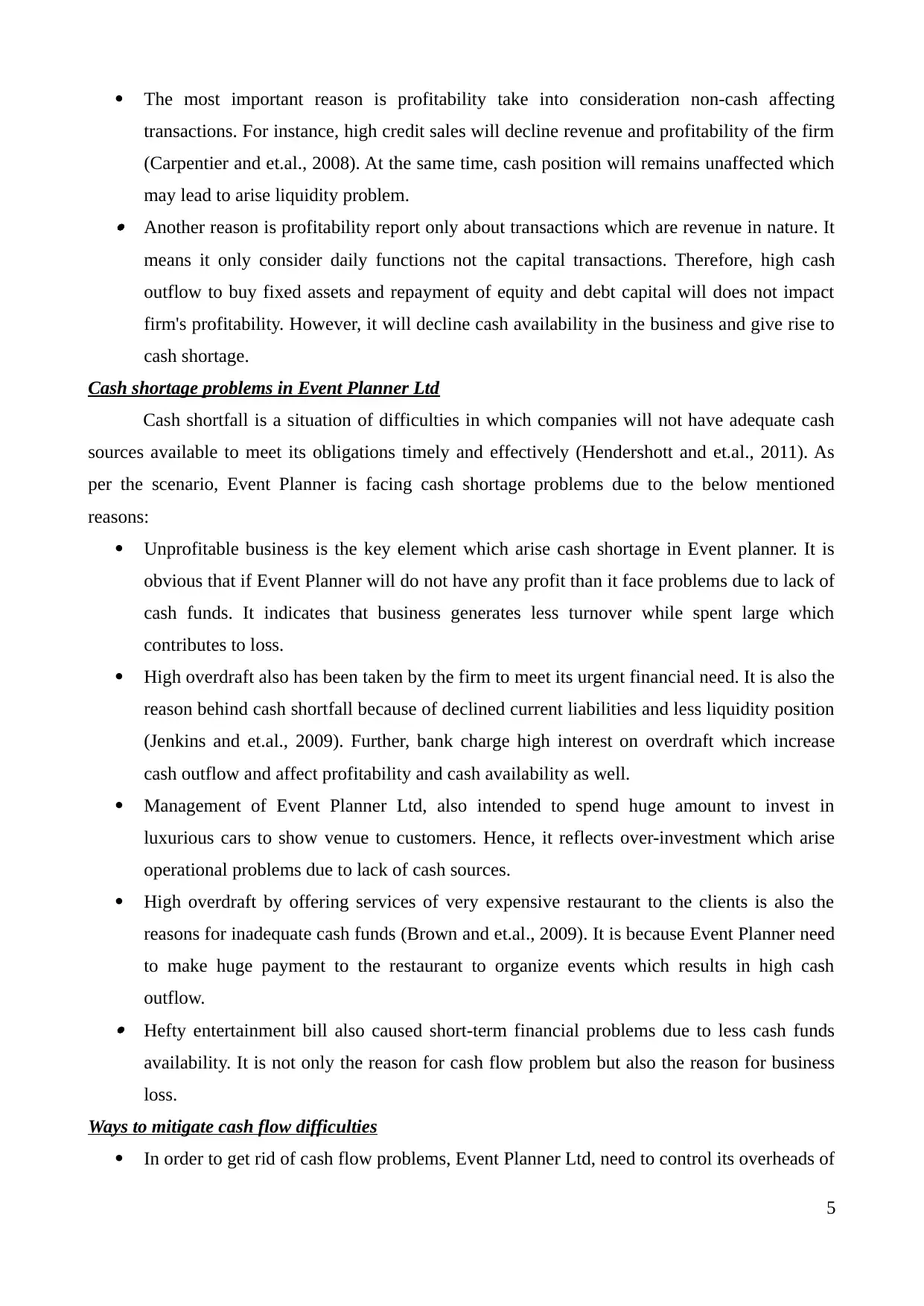
The most important reason is profitability take into consideration non-cash affecting
transactions. For instance, high credit sales will decline revenue and profitability of the firm
(Carpentier and et.al., 2008). At the same time, cash position will remains unaffected which
may lead to arise liquidity problem. Another reason is profitability report only about transactions which are revenue in nature. It
means it only consider daily functions not the capital transactions. Therefore, high cash
outflow to buy fixed assets and repayment of equity and debt capital will does not impact
firm's profitability. However, it will decline cash availability in the business and give rise to
cash shortage.
Cash shortage problems in Event Planner Ltd
Cash shortfall is a situation of difficulties in which companies will not have adequate cash
sources available to meet its obligations timely and effectively (Hendershott and et.al., 2011). As
per the scenario, Event Planner is facing cash shortage problems due to the below mentioned
reasons:
Unprofitable business is the key element which arise cash shortage in Event planner. It is
obvious that if Event Planner will do not have any profit than it face problems due to lack of
cash funds. It indicates that business generates less turnover while spent large which
contributes to loss.
High overdraft also has been taken by the firm to meet its urgent financial need. It is also the
reason behind cash shortfall because of declined current liabilities and less liquidity position
(Jenkins and et.al., 2009). Further, bank charge high interest on overdraft which increase
cash outflow and affect profitability and cash availability as well.
Management of Event Planner Ltd, also intended to spend huge amount to invest in
luxurious cars to show venue to customers. Hence, it reflects over-investment which arise
operational problems due to lack of cash sources.
High overdraft by offering services of very expensive restaurant to the clients is also the
reasons for inadequate cash funds (Brown and et.al., 2009). It is because Event Planner need
to make huge payment to the restaurant to organize events which results in high cash
outflow. Hefty entertainment bill also caused short-term financial problems due to less cash funds
availability. It is not only the reason for cash flow problem but also the reason for business
loss.
Ways to mitigate cash flow difficulties
In order to get rid of cash flow problems, Event Planner Ltd, need to control its overheads of
5
transactions. For instance, high credit sales will decline revenue and profitability of the firm
(Carpentier and et.al., 2008). At the same time, cash position will remains unaffected which
may lead to arise liquidity problem. Another reason is profitability report only about transactions which are revenue in nature. It
means it only consider daily functions not the capital transactions. Therefore, high cash
outflow to buy fixed assets and repayment of equity and debt capital will does not impact
firm's profitability. However, it will decline cash availability in the business and give rise to
cash shortage.
Cash shortage problems in Event Planner Ltd
Cash shortfall is a situation of difficulties in which companies will not have adequate cash
sources available to meet its obligations timely and effectively (Hendershott and et.al., 2011). As
per the scenario, Event Planner is facing cash shortage problems due to the below mentioned
reasons:
Unprofitable business is the key element which arise cash shortage in Event planner. It is
obvious that if Event Planner will do not have any profit than it face problems due to lack of
cash funds. It indicates that business generates less turnover while spent large which
contributes to loss.
High overdraft also has been taken by the firm to meet its urgent financial need. It is also the
reason behind cash shortfall because of declined current liabilities and less liquidity position
(Jenkins and et.al., 2009). Further, bank charge high interest on overdraft which increase
cash outflow and affect profitability and cash availability as well.
Management of Event Planner Ltd, also intended to spend huge amount to invest in
luxurious cars to show venue to customers. Hence, it reflects over-investment which arise
operational problems due to lack of cash sources.
High overdraft by offering services of very expensive restaurant to the clients is also the
reasons for inadequate cash funds (Brown and et.al., 2009). It is because Event Planner need
to make huge payment to the restaurant to organize events which results in high cash
outflow. Hefty entertainment bill also caused short-term financial problems due to less cash funds
availability. It is not only the reason for cash flow problem but also the reason for business
loss.
Ways to mitigate cash flow difficulties
In order to get rid of cash flow problems, Event Planner Ltd, need to control its overheads of
5
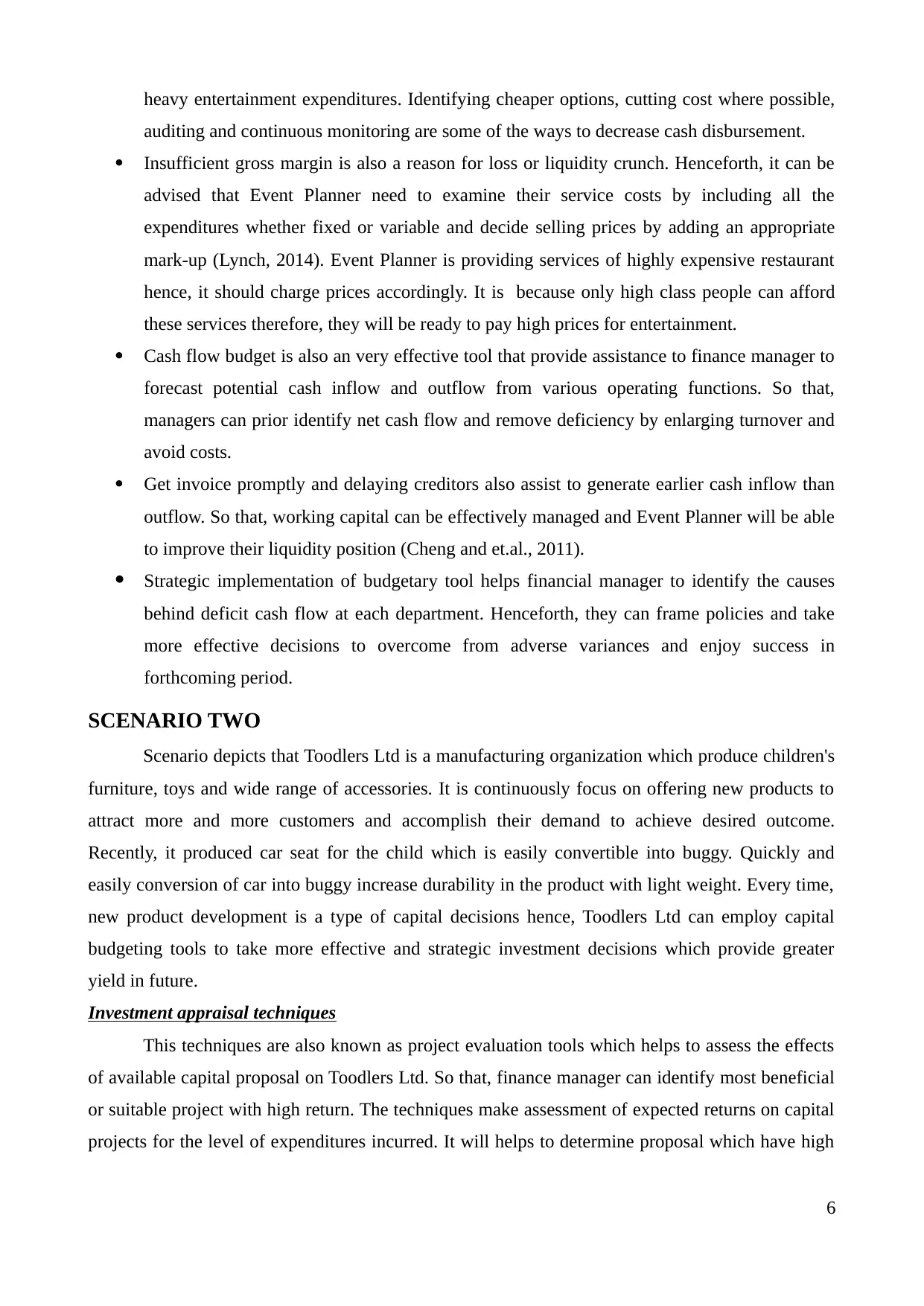
heavy entertainment expenditures. Identifying cheaper options, cutting cost where possible,
auditing and continuous monitoring are some of the ways to decrease cash disbursement.
Insufficient gross margin is also a reason for loss or liquidity crunch. Henceforth, it can be
advised that Event Planner need to examine their service costs by including all the
expenditures whether fixed or variable and decide selling prices by adding an appropriate
mark-up (Lynch, 2014). Event Planner is providing services of highly expensive restaurant
hence, it should charge prices accordingly. It is because only high class people can afford
these services therefore, they will be ready to pay high prices for entertainment.
Cash flow budget is also an very effective tool that provide assistance to finance manager to
forecast potential cash inflow and outflow from various operating functions. So that,
managers can prior identify net cash flow and remove deficiency by enlarging turnover and
avoid costs.
Get invoice promptly and delaying creditors also assist to generate earlier cash inflow than
outflow. So that, working capital can be effectively managed and Event Planner will be able
to improve their liquidity position (Cheng and et.al., 2011).
Strategic implementation of budgetary tool helps financial manager to identify the causes
behind deficit cash flow at each department. Henceforth, they can frame policies and take
more effective decisions to overcome from adverse variances and enjoy success in
forthcoming period.
SCENARIO TWO
Scenario depicts that Toodlers Ltd is a manufacturing organization which produce children's
furniture, toys and wide range of accessories. It is continuously focus on offering new products to
attract more and more customers and accomplish their demand to achieve desired outcome.
Recently, it produced car seat for the child which is easily convertible into buggy. Quickly and
easily conversion of car into buggy increase durability in the product with light weight. Every time,
new product development is a type of capital decisions hence, Toodlers Ltd can employ capital
budgeting tools to take more effective and strategic investment decisions which provide greater
yield in future.
Investment appraisal techniques
This techniques are also known as project evaluation tools which helps to assess the effects
of available capital proposal on Toodlers Ltd. So that, finance manager can identify most beneficial
or suitable project with high return. The techniques make assessment of expected returns on capital
projects for the level of expenditures incurred. It will helps to determine proposal which have high
6
auditing and continuous monitoring are some of the ways to decrease cash disbursement.
Insufficient gross margin is also a reason for loss or liquidity crunch. Henceforth, it can be
advised that Event Planner need to examine their service costs by including all the
expenditures whether fixed or variable and decide selling prices by adding an appropriate
mark-up (Lynch, 2014). Event Planner is providing services of highly expensive restaurant
hence, it should charge prices accordingly. It is because only high class people can afford
these services therefore, they will be ready to pay high prices for entertainment.
Cash flow budget is also an very effective tool that provide assistance to finance manager to
forecast potential cash inflow and outflow from various operating functions. So that,
managers can prior identify net cash flow and remove deficiency by enlarging turnover and
avoid costs.
Get invoice promptly and delaying creditors also assist to generate earlier cash inflow than
outflow. So that, working capital can be effectively managed and Event Planner will be able
to improve their liquidity position (Cheng and et.al., 2011).
Strategic implementation of budgetary tool helps financial manager to identify the causes
behind deficit cash flow at each department. Henceforth, they can frame policies and take
more effective decisions to overcome from adverse variances and enjoy success in
forthcoming period.
SCENARIO TWO
Scenario depicts that Toodlers Ltd is a manufacturing organization which produce children's
furniture, toys and wide range of accessories. It is continuously focus on offering new products to
attract more and more customers and accomplish their demand to achieve desired outcome.
Recently, it produced car seat for the child which is easily convertible into buggy. Quickly and
easily conversion of car into buggy increase durability in the product with light weight. Every time,
new product development is a type of capital decisions hence, Toodlers Ltd can employ capital
budgeting tools to take more effective and strategic investment decisions which provide greater
yield in future.
Investment appraisal techniques
This techniques are also known as project evaluation tools which helps to assess the effects
of available capital proposal on Toodlers Ltd. So that, finance manager can identify most beneficial
or suitable project with high return. The techniques make assessment of expected returns on capital
projects for the level of expenditures incurred. It will helps to determine proposal which have high
6
⊘ This is a preview!⊘
Do you want full access?
Subscribe today to unlock all pages.

Trusted by 1+ million students worldwide
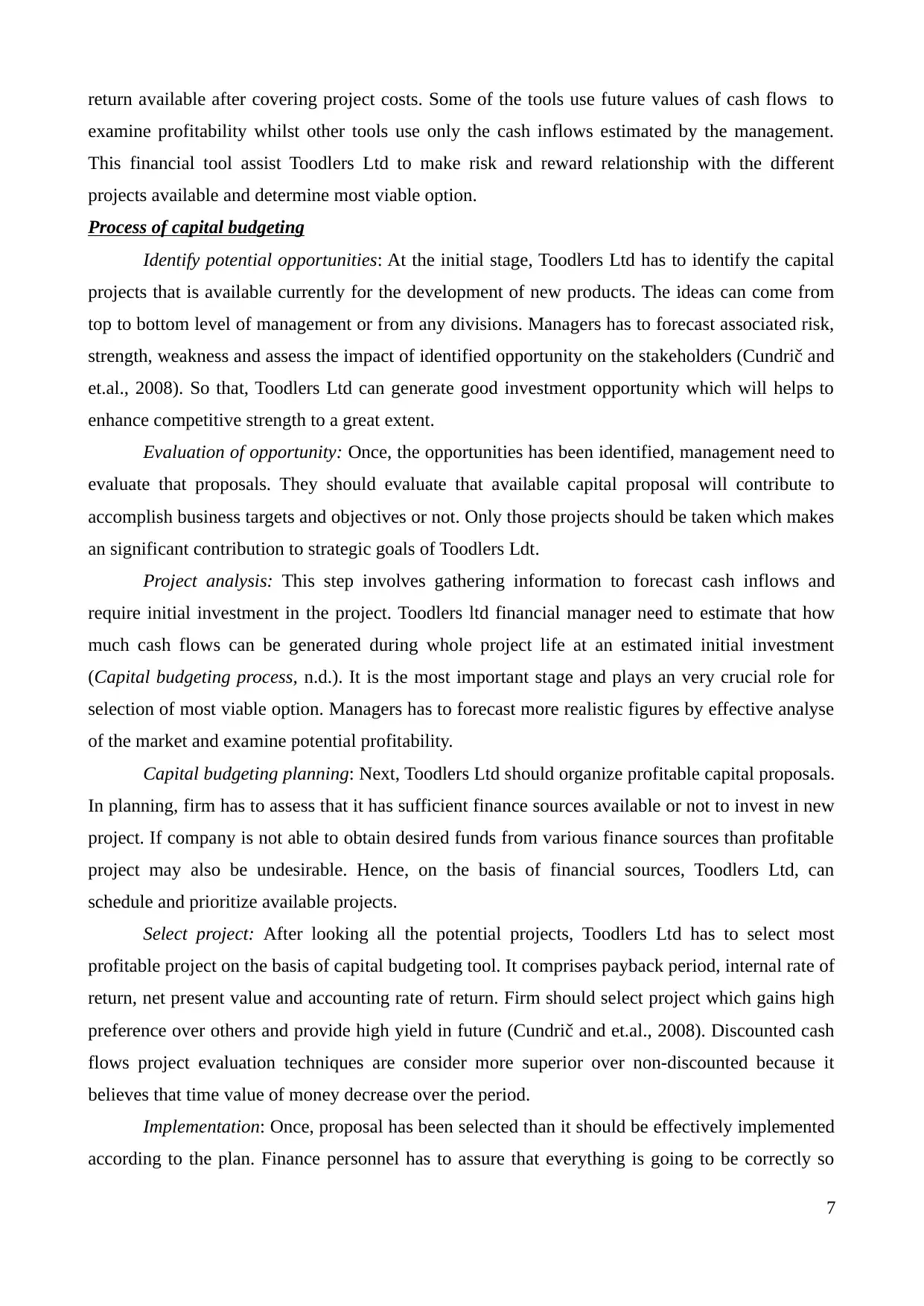
return available after covering project costs. Some of the tools use future values of cash flows to
examine profitability whilst other tools use only the cash inflows estimated by the management.
This financial tool assist Toodlers Ltd to make risk and reward relationship with the different
projects available and determine most viable option.
Process of capital budgeting
Identify potential opportunities: At the initial stage, Toodlers Ltd has to identify the capital
projects that is available currently for the development of new products. The ideas can come from
top to bottom level of management or from any divisions. Managers has to forecast associated risk,
strength, weakness and assess the impact of identified opportunity on the stakeholders (Cundrič and
et.al., 2008). So that, Toodlers Ltd can generate good investment opportunity which will helps to
enhance competitive strength to a great extent.
Evaluation of opportunity: Once, the opportunities has been identified, management need to
evaluate that proposals. They should evaluate that available capital proposal will contribute to
accomplish business targets and objectives or not. Only those projects should be taken which makes
an significant contribution to strategic goals of Toodlers Ldt.
Project analysis: This step involves gathering information to forecast cash inflows and
require initial investment in the project. Toodlers ltd financial manager need to estimate that how
much cash flows can be generated during whole project life at an estimated initial investment
(Capital budgeting process, n.d.). It is the most important stage and plays an very crucial role for
selection of most viable option. Managers has to forecast more realistic figures by effective analyse
of the market and examine potential profitability.
Capital budgeting planning: Next, Toodlers Ltd should organize profitable capital proposals.
In planning, firm has to assess that it has sufficient finance sources available or not to invest in new
project. If company is not able to obtain desired funds from various finance sources than profitable
project may also be undesirable. Hence, on the basis of financial sources, Toodlers Ltd, can
schedule and prioritize available projects.
Select project: After looking all the potential projects, Toodlers Ltd has to select most
profitable project on the basis of capital budgeting tool. It comprises payback period, internal rate of
return, net present value and accounting rate of return. Firm should select project which gains high
preference over others and provide high yield in future (Cundrič and et.al., 2008). Discounted cash
flows project evaluation techniques are consider more superior over non-discounted because it
believes that time value of money decrease over the period.
Implementation: Once, proposal has been selected than it should be effectively implemented
according to the plan. Finance personnel has to assure that everything is going to be correctly so
7
examine profitability whilst other tools use only the cash inflows estimated by the management.
This financial tool assist Toodlers Ltd to make risk and reward relationship with the different
projects available and determine most viable option.
Process of capital budgeting
Identify potential opportunities: At the initial stage, Toodlers Ltd has to identify the capital
projects that is available currently for the development of new products. The ideas can come from
top to bottom level of management or from any divisions. Managers has to forecast associated risk,
strength, weakness and assess the impact of identified opportunity on the stakeholders (Cundrič and
et.al., 2008). So that, Toodlers Ltd can generate good investment opportunity which will helps to
enhance competitive strength to a great extent.
Evaluation of opportunity: Once, the opportunities has been identified, management need to
evaluate that proposals. They should evaluate that available capital proposal will contribute to
accomplish business targets and objectives or not. Only those projects should be taken which makes
an significant contribution to strategic goals of Toodlers Ldt.
Project analysis: This step involves gathering information to forecast cash inflows and
require initial investment in the project. Toodlers ltd financial manager need to estimate that how
much cash flows can be generated during whole project life at an estimated initial investment
(Capital budgeting process, n.d.). It is the most important stage and plays an very crucial role for
selection of most viable option. Managers has to forecast more realistic figures by effective analyse
of the market and examine potential profitability.
Capital budgeting planning: Next, Toodlers Ltd should organize profitable capital proposals.
In planning, firm has to assess that it has sufficient finance sources available or not to invest in new
project. If company is not able to obtain desired funds from various finance sources than profitable
project may also be undesirable. Hence, on the basis of financial sources, Toodlers Ltd, can
schedule and prioritize available projects.
Select project: After looking all the potential projects, Toodlers Ltd has to select most
profitable project on the basis of capital budgeting tool. It comprises payback period, internal rate of
return, net present value and accounting rate of return. Firm should select project which gains high
preference over others and provide high yield in future (Cundrič and et.al., 2008). Discounted cash
flows project evaluation techniques are consider more superior over non-discounted because it
believes that time value of money decrease over the period.
Implementation: Once, proposal has been selected than it should be effectively implemented
according to the plan. Finance personnel has to assure that everything is going to be correctly so
7
Paraphrase This Document
Need a fresh take? Get an instant paraphrase of this document with our AI Paraphraser
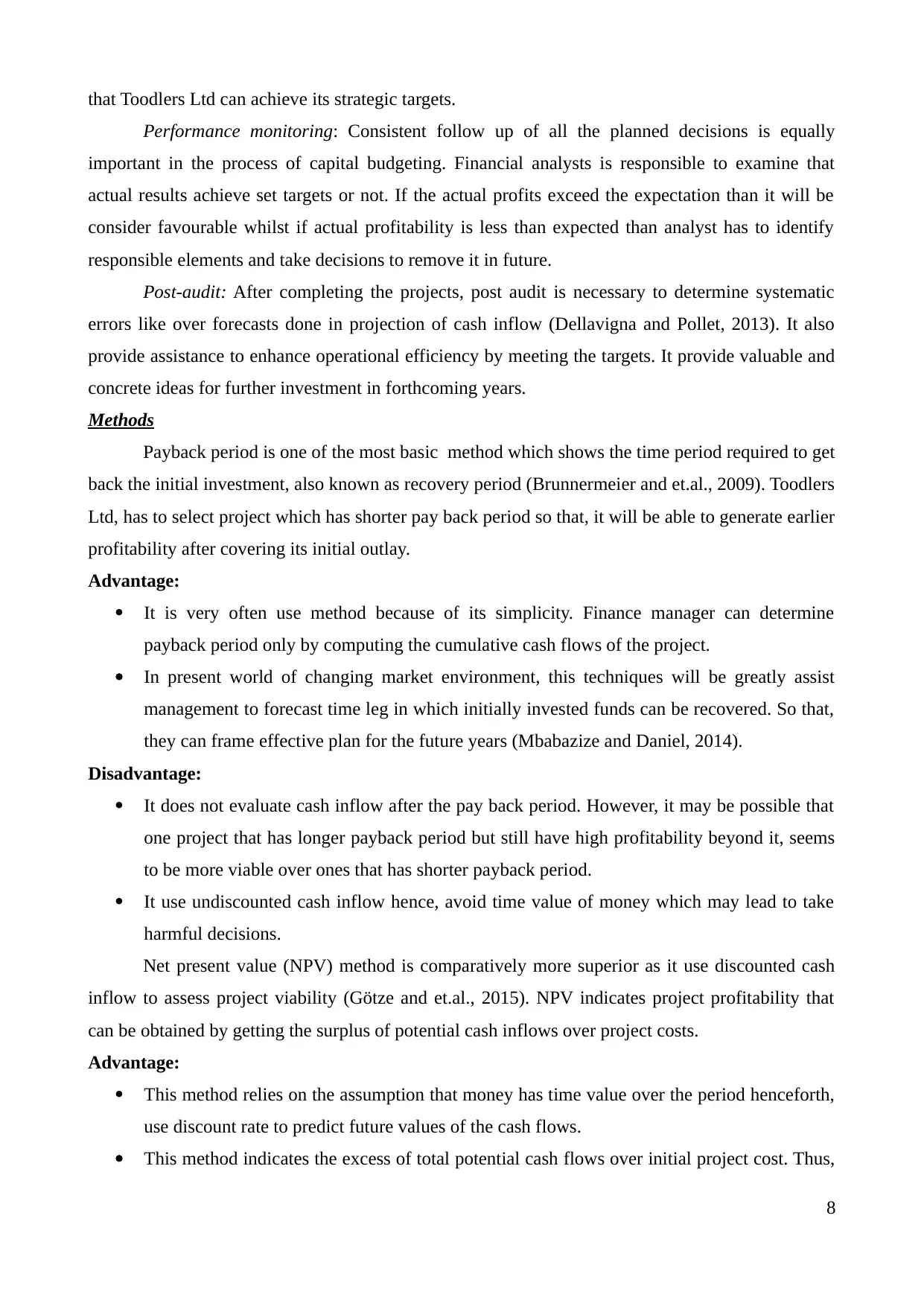
that Toodlers Ltd can achieve its strategic targets.
Performance monitoring: Consistent follow up of all the planned decisions is equally
important in the process of capital budgeting. Financial analysts is responsible to examine that
actual results achieve set targets or not. If the actual profits exceed the expectation than it will be
consider favourable whilst if actual profitability is less than expected than analyst has to identify
responsible elements and take decisions to remove it in future.
Post-audit: After completing the projects, post audit is necessary to determine systematic
errors like over forecasts done in projection of cash inflow (Dellavigna and Pollet, 2013). It also
provide assistance to enhance operational efficiency by meeting the targets. It provide valuable and
concrete ideas for further investment in forthcoming years.
Methods
Payback period is one of the most basic method which shows the time period required to get
back the initial investment, also known as recovery period (Brunnermeier and et.al., 2009). Toodlers
Ltd, has to select project which has shorter pay back period so that, it will be able to generate earlier
profitability after covering its initial outlay.
Advantage:
It is very often use method because of its simplicity. Finance manager can determine
payback period only by computing the cumulative cash flows of the project.
In present world of changing market environment, this techniques will be greatly assist
management to forecast time leg in which initially invested funds can be recovered. So that,
they can frame effective plan for the future years (Mbabazize and Daniel, 2014).
Disadvantage:
It does not evaluate cash inflow after the pay back period. However, it may be possible that
one project that has longer payback period but still have high profitability beyond it, seems
to be more viable over ones that has shorter payback period.
It use undiscounted cash inflow hence, avoid time value of money which may lead to take
harmful decisions.
Net present value (NPV) method is comparatively more superior as it use discounted cash
inflow to assess project viability (Götze and et.al., 2015). NPV indicates project profitability that
can be obtained by getting the surplus of potential cash inflows over project costs.
Advantage:
This method relies on the assumption that money has time value over the period henceforth,
use discount rate to predict future values of the cash flows.
This method indicates the excess of total potential cash flows over initial project cost. Thus,
8
Performance monitoring: Consistent follow up of all the planned decisions is equally
important in the process of capital budgeting. Financial analysts is responsible to examine that
actual results achieve set targets or not. If the actual profits exceed the expectation than it will be
consider favourable whilst if actual profitability is less than expected than analyst has to identify
responsible elements and take decisions to remove it in future.
Post-audit: After completing the projects, post audit is necessary to determine systematic
errors like over forecasts done in projection of cash inflow (Dellavigna and Pollet, 2013). It also
provide assistance to enhance operational efficiency by meeting the targets. It provide valuable and
concrete ideas for further investment in forthcoming years.
Methods
Payback period is one of the most basic method which shows the time period required to get
back the initial investment, also known as recovery period (Brunnermeier and et.al., 2009). Toodlers
Ltd, has to select project which has shorter pay back period so that, it will be able to generate earlier
profitability after covering its initial outlay.
Advantage:
It is very often use method because of its simplicity. Finance manager can determine
payback period only by computing the cumulative cash flows of the project.
In present world of changing market environment, this techniques will be greatly assist
management to forecast time leg in which initially invested funds can be recovered. So that,
they can frame effective plan for the future years (Mbabazize and Daniel, 2014).
Disadvantage:
It does not evaluate cash inflow after the pay back period. However, it may be possible that
one project that has longer payback period but still have high profitability beyond it, seems
to be more viable over ones that has shorter payback period.
It use undiscounted cash inflow hence, avoid time value of money which may lead to take
harmful decisions.
Net present value (NPV) method is comparatively more superior as it use discounted cash
inflow to assess project viability (Götze and et.al., 2015). NPV indicates project profitability that
can be obtained by getting the surplus of potential cash inflows over project costs.
Advantage:
This method relies on the assumption that money has time value over the period henceforth,
use discount rate to predict future values of the cash flows.
This method indicates the excess of total potential cash flows over initial project cost. Thus,
8
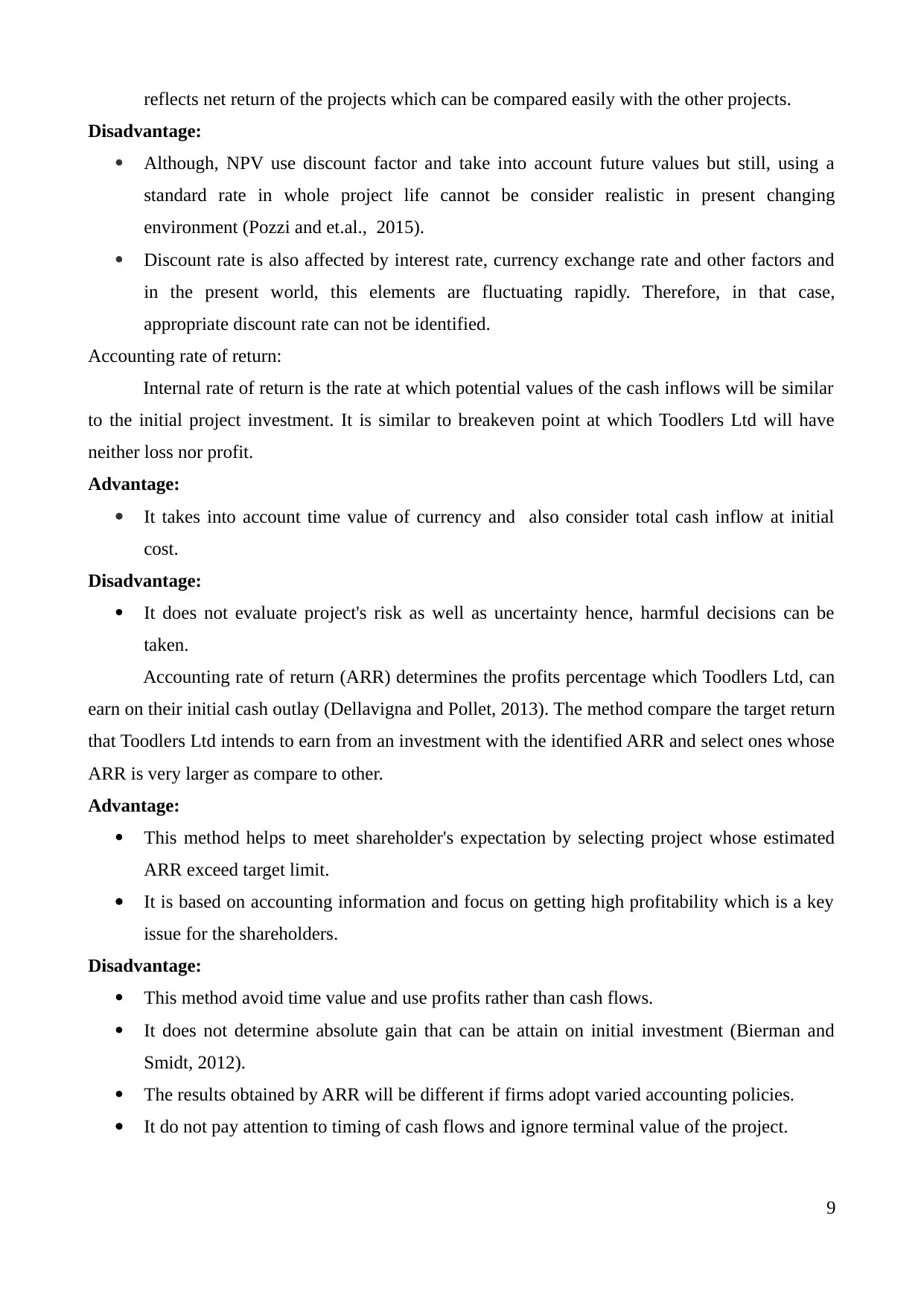
reflects net return of the projects which can be compared easily with the other projects.
Disadvantage:
Although, NPV use discount factor and take into account future values but still, using a
standard rate in whole project life cannot be consider realistic in present changing
environment (Pozzi and et.al., 2015).
Discount rate is also affected by interest rate, currency exchange rate and other factors and
in the present world, this elements are fluctuating rapidly. Therefore, in that case,
appropriate discount rate can not be identified.
Accounting rate of return:
Internal rate of return is the rate at which potential values of the cash inflows will be similar
to the initial project investment. It is similar to breakeven point at which Toodlers Ltd will have
neither loss nor profit.
Advantage:
It takes into account time value of currency and also consider total cash inflow at initial
cost.
Disadvantage:
It does not evaluate project's risk as well as uncertainty hence, harmful decisions can be
taken.
Accounting rate of return (ARR) determines the profits percentage which Toodlers Ltd, can
earn on their initial cash outlay (Dellavigna and Pollet, 2013). The method compare the target return
that Toodlers Ltd intends to earn from an investment with the identified ARR and select ones whose
ARR is very larger as compare to other.
Advantage:
This method helps to meet shareholder's expectation by selecting project whose estimated
ARR exceed target limit.
It is based on accounting information and focus on getting high profitability which is a key
issue for the shareholders.
Disadvantage:
This method avoid time value and use profits rather than cash flows.
It does not determine absolute gain that can be attain on initial investment (Bierman and
Smidt, 2012).
The results obtained by ARR will be different if firms adopt varied accounting policies.
It do not pay attention to timing of cash flows and ignore terminal value of the project.
9
Disadvantage:
Although, NPV use discount factor and take into account future values but still, using a
standard rate in whole project life cannot be consider realistic in present changing
environment (Pozzi and et.al., 2015).
Discount rate is also affected by interest rate, currency exchange rate and other factors and
in the present world, this elements are fluctuating rapidly. Therefore, in that case,
appropriate discount rate can not be identified.
Accounting rate of return:
Internal rate of return is the rate at which potential values of the cash inflows will be similar
to the initial project investment. It is similar to breakeven point at which Toodlers Ltd will have
neither loss nor profit.
Advantage:
It takes into account time value of currency and also consider total cash inflow at initial
cost.
Disadvantage:
It does not evaluate project's risk as well as uncertainty hence, harmful decisions can be
taken.
Accounting rate of return (ARR) determines the profits percentage which Toodlers Ltd, can
earn on their initial cash outlay (Dellavigna and Pollet, 2013). The method compare the target return
that Toodlers Ltd intends to earn from an investment with the identified ARR and select ones whose
ARR is very larger as compare to other.
Advantage:
This method helps to meet shareholder's expectation by selecting project whose estimated
ARR exceed target limit.
It is based on accounting information and focus on getting high profitability which is a key
issue for the shareholders.
Disadvantage:
This method avoid time value and use profits rather than cash flows.
It does not determine absolute gain that can be attain on initial investment (Bierman and
Smidt, 2012).
The results obtained by ARR will be different if firms adopt varied accounting policies.
It do not pay attention to timing of cash flows and ignore terminal value of the project.
9
⊘ This is a preview!⊘
Do you want full access?
Subscribe today to unlock all pages.

Trusted by 1+ million students worldwide
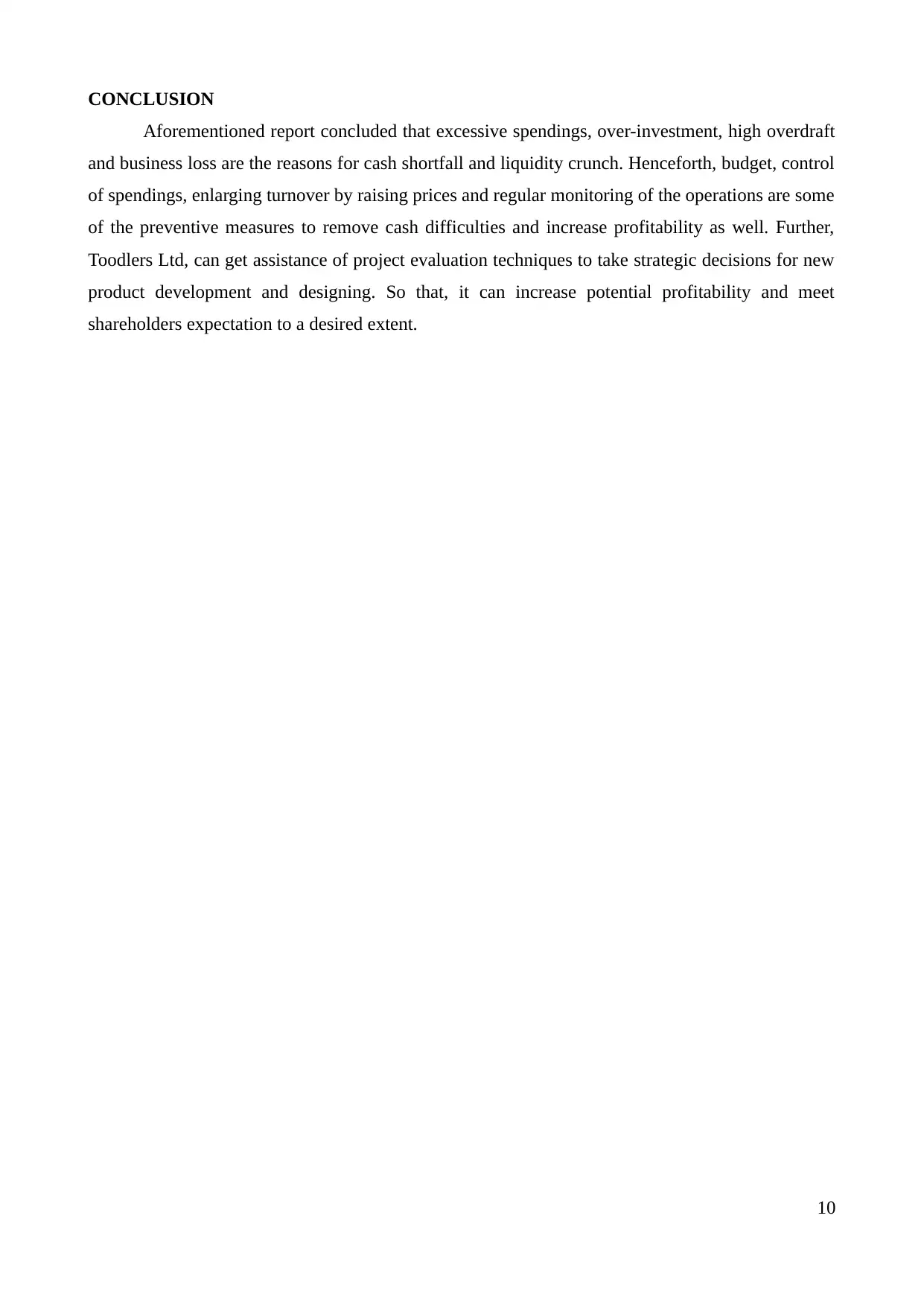
CONCLUSION
Aforementioned report concluded that excessive spendings, over-investment, high overdraft
and business loss are the reasons for cash shortfall and liquidity crunch. Henceforth, budget, control
of spendings, enlarging turnover by raising prices and regular monitoring of the operations are some
of the preventive measures to remove cash difficulties and increase profitability as well. Further,
Toodlers Ltd, can get assistance of project evaluation techniques to take strategic decisions for new
product development and designing. So that, it can increase potential profitability and meet
shareholders expectation to a desired extent.
10
Aforementioned report concluded that excessive spendings, over-investment, high overdraft
and business loss are the reasons for cash shortfall and liquidity crunch. Henceforth, budget, control
of spendings, enlarging turnover by raising prices and regular monitoring of the operations are some
of the preventive measures to remove cash difficulties and increase profitability as well. Further,
Toodlers Ltd, can get assistance of project evaluation techniques to take strategic decisions for new
product development and designing. So that, it can increase potential profitability and meet
shareholders expectation to a desired extent.
10
Paraphrase This Document
Need a fresh take? Get an instant paraphrase of this document with our AI Paraphraser
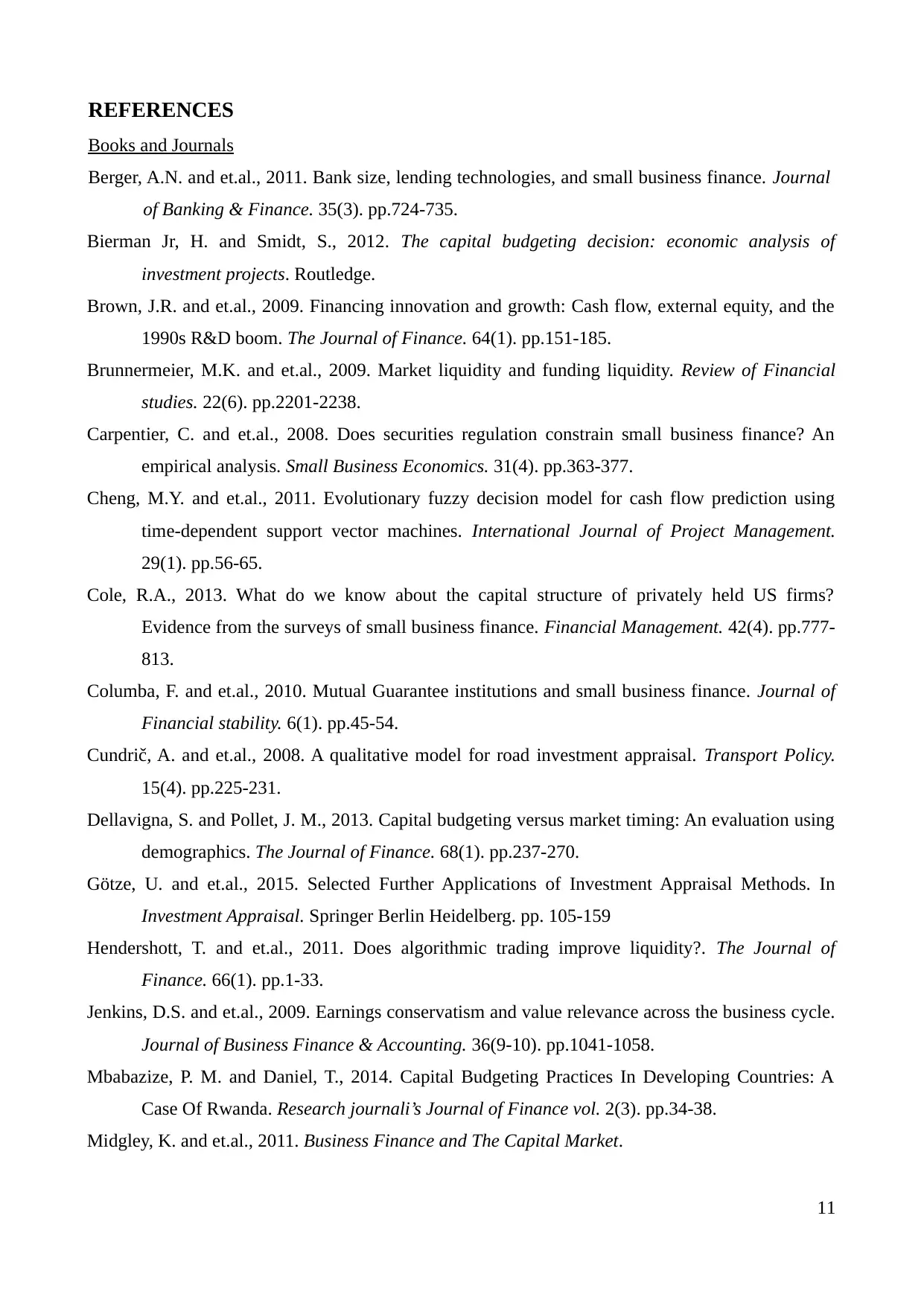
REFERENCES
Books and Journals
Berger, A.N. and et.al., 2011. Bank size, lending technologies, and small business finance. Journal
of Banking & Finance. 35(3). pp.724-735.
Bierman Jr, H. and Smidt, S., 2012. The capital budgeting decision: economic analysis of
investment projects. Routledge.
Brown, J.R. and et.al., 2009. Financing innovation and growth: Cash flow, external equity, and the
1990s R&D boom. The Journal of Finance. 64(1). pp.151-185.
Brunnermeier, M.K. and et.al., 2009. Market liquidity and funding liquidity. Review of Financial
studies. 22(6). pp.2201-2238.
Carpentier, C. and et.al., 2008. Does securities regulation constrain small business finance? An
empirical analysis. Small Business Economics. 31(4). pp.363-377.
Cheng, M.Y. and et.al., 2011. Evolutionary fuzzy decision model for cash flow prediction using
time-dependent support vector machines. International Journal of Project Management.
29(1). pp.56-65.
Cole, R.A., 2013. What do we know about the capital structure of privately held US firms?
Evidence from the surveys of small business finance. Financial Management. 42(4). pp.777-
813.
Columba, F. and et.al., 2010. Mutual Guarantee institutions and small business finance. Journal of
Financial stability. 6(1). pp.45-54.
Cundrič, A. and et.al., 2008. A qualitative model for road investment appraisal. Transport Policy.
15(4). pp.225-231.
Dellavigna, S. and Pollet, J. M., 2013. Capital budgeting versus market timing: An evaluation using
demographics. The Journal of Finance. 68(1). pp.237-270.
Götze, U. and et.al., 2015. Selected Further Applications of Investment Appraisal Methods. In
Investment Appraisal. Springer Berlin Heidelberg. pp. 105-159
Hendershott, T. and et.al., 2011. Does algorithmic trading improve liquidity?. The Journal of
Finance. 66(1). pp.1-33.
Jenkins, D.S. and et.al., 2009. Earnings conservatism and value relevance across the business cycle.
Journal of Business Finance & Accounting. 36(9‐10). pp.1041-1058.
Mbabazize, P. M. and Daniel, T., 2014. Capital Budgeting Practices In Developing Countries: A
Case Of Rwanda. Research journali’s Journal of Finance vol. 2(3). pp.34-38.
Midgley, K. and et.al., 2011. Business Finance and The Capital Market.
11
Books and Journals
Berger, A.N. and et.al., 2011. Bank size, lending technologies, and small business finance. Journal
of Banking & Finance. 35(3). pp.724-735.
Bierman Jr, H. and Smidt, S., 2012. The capital budgeting decision: economic analysis of
investment projects. Routledge.
Brown, J.R. and et.al., 2009. Financing innovation and growth: Cash flow, external equity, and the
1990s R&D boom. The Journal of Finance. 64(1). pp.151-185.
Brunnermeier, M.K. and et.al., 2009. Market liquidity and funding liquidity. Review of Financial
studies. 22(6). pp.2201-2238.
Carpentier, C. and et.al., 2008. Does securities regulation constrain small business finance? An
empirical analysis. Small Business Economics. 31(4). pp.363-377.
Cheng, M.Y. and et.al., 2011. Evolutionary fuzzy decision model for cash flow prediction using
time-dependent support vector machines. International Journal of Project Management.
29(1). pp.56-65.
Cole, R.A., 2013. What do we know about the capital structure of privately held US firms?
Evidence from the surveys of small business finance. Financial Management. 42(4). pp.777-
813.
Columba, F. and et.al., 2010. Mutual Guarantee institutions and small business finance. Journal of
Financial stability. 6(1). pp.45-54.
Cundrič, A. and et.al., 2008. A qualitative model for road investment appraisal. Transport Policy.
15(4). pp.225-231.
Dellavigna, S. and Pollet, J. M., 2013. Capital budgeting versus market timing: An evaluation using
demographics. The Journal of Finance. 68(1). pp.237-270.
Götze, U. and et.al., 2015. Selected Further Applications of Investment Appraisal Methods. In
Investment Appraisal. Springer Berlin Heidelberg. pp. 105-159
Hendershott, T. and et.al., 2011. Does algorithmic trading improve liquidity?. The Journal of
Finance. 66(1). pp.1-33.
Jenkins, D.S. and et.al., 2009. Earnings conservatism and value relevance across the business cycle.
Journal of Business Finance & Accounting. 36(9‐10). pp.1041-1058.
Mbabazize, P. M. and Daniel, T., 2014. Capital Budgeting Practices In Developing Countries: A
Case Of Rwanda. Research journali’s Journal of Finance vol. 2(3). pp.34-38.
Midgley, K. and et.al., 2011. Business Finance and The Capital Market.
11
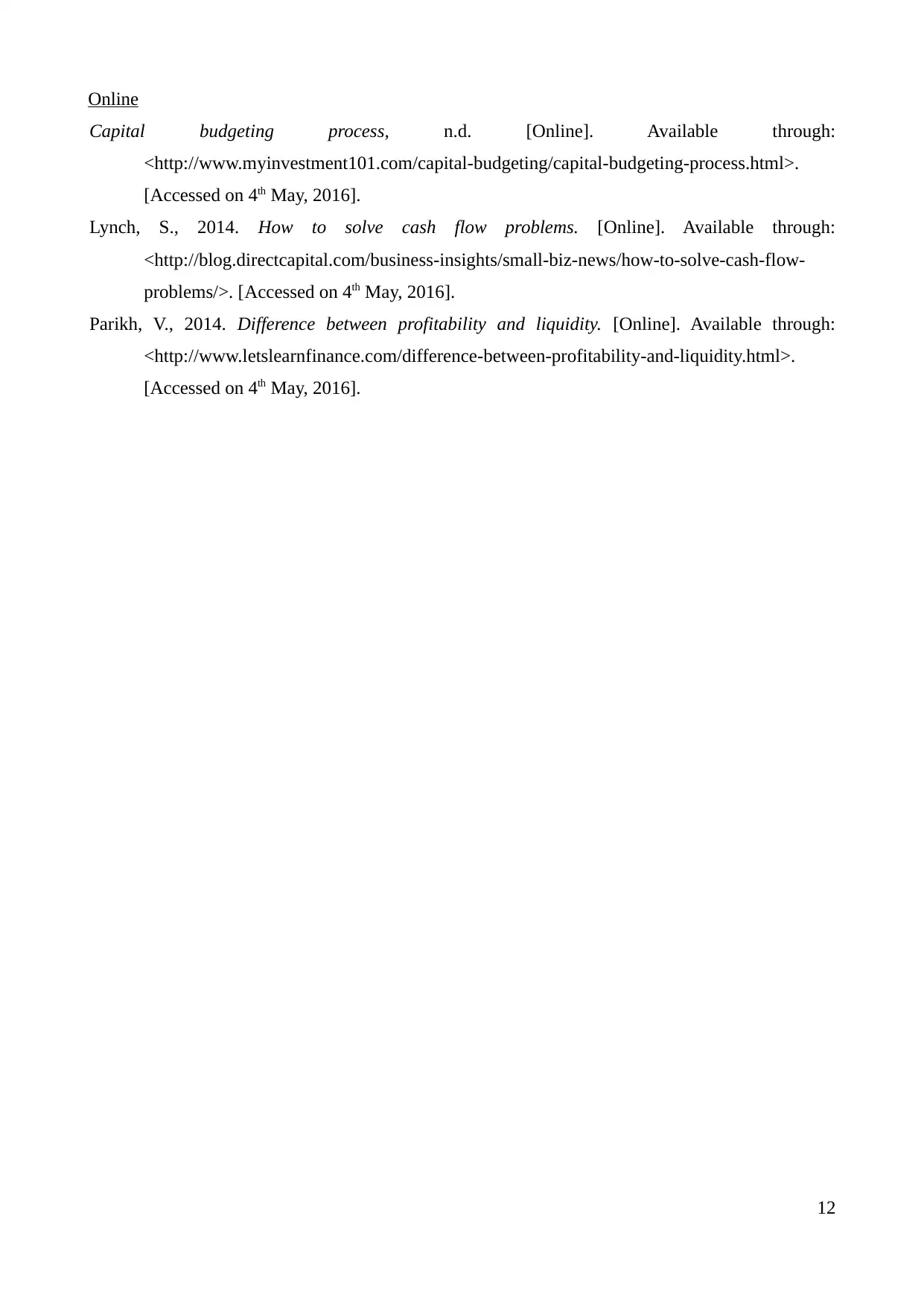
Online
Capital budgeting process, n.d. [Online]. Available through:
<http://www.myinvestment101.com/capital-budgeting/capital-budgeting-process.html>.
[Accessed on 4th May, 2016].
Lynch, S., 2014. How to solve cash flow problems. [Online]. Available through:
<http://blog.directcapital.com/business-insights/small-biz-news/how-to-solve-cash-flow-
problems/>. [Accessed on 4th May, 2016].
Parikh, V., 2014. Difference between profitability and liquidity. [Online]. Available through:
<http://www.letslearnfinance.com/difference-between-profitability-and-liquidity.html>.
[Accessed on 4th May, 2016].
12
Capital budgeting process, n.d. [Online]. Available through:
<http://www.myinvestment101.com/capital-budgeting/capital-budgeting-process.html>.
[Accessed on 4th May, 2016].
Lynch, S., 2014. How to solve cash flow problems. [Online]. Available through:
<http://blog.directcapital.com/business-insights/small-biz-news/how-to-solve-cash-flow-
problems/>. [Accessed on 4th May, 2016].
Parikh, V., 2014. Difference between profitability and liquidity. [Online]. Available through:
<http://www.letslearnfinance.com/difference-between-profitability-and-liquidity.html>.
[Accessed on 4th May, 2016].
12
⊘ This is a preview!⊘
Do you want full access?
Subscribe today to unlock all pages.

Trusted by 1+ million students worldwide
1 out of 13
Related Documents
Your All-in-One AI-Powered Toolkit for Academic Success.
+13062052269
info@desklib.com
Available 24*7 on WhatsApp / Email
![[object Object]](/_next/static/media/star-bottom.7253800d.svg)
Unlock your academic potential
Copyright © 2020–2025 A2Z Services. All Rights Reserved. Developed and managed by ZUCOL.





